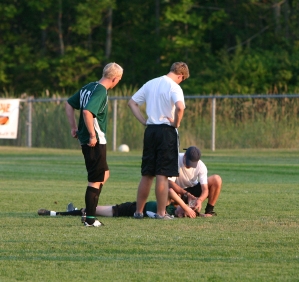Concussions can occur with or without
LOC. In fact, the vast majority of concussions (more than 95% in a 2010 study of concussion among high school athletes)1 do not result in LOC, a rate less than half the 10-11% reported in previous
studies.

Until the mid-2000's, however, LOC "featured prominently in published concussion severity scales as being associated with more severe injuries."2 Any LOC, however brief, caused the concussion to be classified as a Grade 3 (severe) concussion.
As sports concussion neuropsychologist and MomsTEAM expert Rosemarie Scolaro Moser, PhD, notes in her 2011 book, Ahead of the Game, "It's not really hard to understand why for so long, loss of consciousness was considered an appropriate indicator of the severity of a concussion. After all, when an athlete has actually been knocked out, even if for a few seconds, it just seems like a more serious injury than one that leaves the athlete feeling only a little dazed."
Recent studies on sport-related concussions, however, have consistently demonstrated that brief (less than 1 minute) LOC does not reflect injury severity or predict time to recovery, although the results of a large-scale study of extended (7 or more days) recovery in NFL players demonstrated that prolonged LOC (greater than 1 minute) was associated with delayed return to play.
As a result, the most recent consensus of sports concussion experts3 is that prolonged LOC (e.g. greater than one minute duration) provides preliminary evidence for caution so that it is listed as one of the "modifying" factors that may influence management of such concussions.
In a 2010 statement on concussions,4 the American Academy of Pediatrics, however, takes a more conservative approach, stating that LOC lasting longer than 30 seconds may indicate a more significant intracranial injury.
For the most comprehensive, up-to-date concussion information on the Internet, click here.
1. Meehan W, d'Hemecourt P, Comstock D, "High School Concussions in the 2008-2009 Academic Year: Mechanism, Symptoms, and Management" Am. J. Sports. Med. 2010; 38(12): 2405-2409 (accessed December 2, 2010 at http://ajs.sagepub.com/content/38/12/2405.abstract?etoc).
2.Makdissi, M. Is the simple versus complex classification of concussion a valid and useful differentiation? Br. J. Sports Med. 2009; 43;123-127
3. McCrory P. et al. Consensus Statement on Concussion in Sport: the 4th International Conference on Concussion in Sport held in Zurich, November 2012 .Br. J. Sports Med. 2013; 47:250-258.
4. Halstead, M, Walter, K. "Clinical Report - Sport-Related Concussion in Children and Adolescents" Pediatrics. 2010;126(3):597-615.
Most recently revised November 30, 2015









